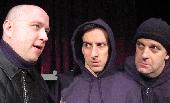SEARCH
REVIEWS
FEATURES
NEWS
Etcetera and
Short Term Listings
LISTINGS
Broadway
Off-Broadway
NYC Restaurants
BOOKS and CDs
OTHER PLACES
Berkshires
London
California
DC
Philadelphia
Elsewhere
QUOTES
On TKTS
PLAYWRIGHTS' ALBUMS
LETTERS TO EDITOR
FILM
LINKS
MISCELLANEOUS
Free Updates
Masthead
Writing for Us
A CurtainUp Review
Richard III
| Shine out, fair sun, till I have bought a glass, That I may see my shadow as I pass. --- Richard |

From left to right: Pete Pryor, Dave Jadico& John Lopes.
(Photo: Sara Pauley ) |
If I'd had to guess which Philadelphia actor would play Richard, Pete Pryor wouldn't have been my first guess. But the idea of this actor undertaking the role intrigued me. Pryor was co-founder and and is currently Resident Artist at 1812 Productions, whose mission is comedy, and he has appeared at other venues, largely in humorous plays. Closer to the subject at hand, he was Duke Cesare Borgia in David Davalos's Daedalus: A Fantasia of Leonardo da Vinci (Arden). Although that role was Borgia-lite, it connects through unscrupulousness with the Richard role. Among Pete Pryor's strengths are his rapt attention to others as they speak and his ability to move about while transmitting subtle, even contradictory shades of meaning without breaking a sweat. I don't know if Mr. Pryor ever played anything approaching the demands of the heavy of heavies, Richard III, before tackling this intimidating dream role.
It turns out that Pryor is strangely suitable for this part. He handles particularly well the disingenuousness of Richard who must be begged to be king. And in the key scene with Anne, (Kate Hurster, who wears stiletto heels) his protestations of love are played for comedy on the side. In the important, outrageous scene with Elizabeth (Sally Mercer), where he begs her daughter's hand in marriage right after he has had her young sons murdered, his Richard slides through permutations of wheedler, comedian and thug. Then his eyes literally glint as he keeps Buckingham physically off balance in a power move. Still, on this opening night a sense of restraint colors his depiction of no-holds-barred, rough evil. During the run, I believe he will cut loose, let 'er rip, and fully come into his own.
Charles McMahon directed the award-winning, quintessential Lantern Shakespeare production, The Comedy of Errors in '04. Compared to the directing challenges presented by this unwieldy play, The Comedy of Errors looks like... well, comedy. With Richard III's sheer number and confusing array of characters, some of whom use a given name and title interchangeably, and with a panorama of murders going back to previous plays, it is a challenge to find ways to maintain clarity. It's no wonder that even this fine production occasionally is confusing. However, the energy and capabilities of the cast, a force to be reckoned with, and McMahon's way of including the audience, surely make this lively Richard III generally comprehensible for those who may be unfamiliar with the story.
Millie Hiibel's costumes work. The look is modern --dressed down and dressed up-- mixed with something loosely stage-Elizabethan. The cast is well-chosen. Kate Hurster does a delicate Lady Anne and she has a lovely voice. Sparks fly with Sally Mercer's Queen Elizabeth. The Catesby/Richmond, devil/angel combo shows off Patrick Doran's versatility and range. Dave Jadico, who was Dromio in that legendary The Comedy of Errors, plays his every role here to the hilt with humor, efficiency, or whatever is called for. Paul Nolan's sturdy Buckingham is suitably substantial, conservative, and of course, untrustworthy. Lindsay Smiling is a graceful, natural Clarence and a good sickly Edward, among other parts. John Lopes's murderer almost outshines his Hastings and his Duchess of York, and Jane Moore is strong in her various roles, among them the disagreeable Queen Margaret.
There are a few problems. Gender-blind casting is fine as a general rule, but it doesn't always work in this play's favor. A case in point: a scruffy male ruffian would be preferable in the small, but important role of Sir James Tyrrel, the child murderer. While Mercer's work as Elizabeth is fantastic, her Tyrrel leaves much to be desired. Role doubling and quadrupling is also fine, but the moment when George, Duke of Clarence morphs into the ailing King Edward doesn't read well. Instead of being dumped into a malmsey vat Clarence incongruously dons a long royal robe. The situation immediately becomes clear, but this serves as an example of a moment of unnecessary confusion within the play's confusion of characters.
There are numerous good moves and nice moments: After the intermission the scene opens with Richard, "hell's black intelligencer," ensconced in his throne in the stage's upper level, at once removed and visually dominating the activity taking place below.
Aided by good lighting and sound design, and impeccable timing, McMahon beautifully manages Richard's ghost-visited nightmare, a scene that is almost impossible to stage well. There's a good ending battle, with loud booming and flashes of light briefly illuminating people with guns, showing Richard surrounded. Richmond wins. Kate Hurster sings from Blake's "Jerusalem." Beautiful.
|
Richard III
By William Shakespeare Directed by Charles McMahon Cast: Patrick Doran, Kate Hurster, Dave Jadico, John Lopes, Sally Mercer, Jane Moore, Paul Nolan, Pete Pryor, Lindsay Smiling Set Design: Nick Embree Lighting Design: Janet Embree Costume Design: Millie Hiibel Sound Design: Nick Rye Lantern Theater Company at St. Stephen's Theater, 10th and Ludlow Sts. Running time: 2 hrs, 45 mins including one 12 min intermission 03/24/06 through 04/30/06 Reviewed byKathryn Osenlund based on 03/29/06 performance. |
The Internet Theatre Bookshop "Virtually Every Play in the World" --even out of print plays

Easy-on-the budget super gift for yourself and your musical loving friends. Tons of gorgeous pictures.

Retold by Tina Packer of Shakespeare & Co.
Click image to buy.
Our Review
Leonard Maltin's 2005 Movie Guide

6, 500 Comparative Phrases including 800 Shakespearean Metaphors by our editor.
Click image to buy.
Go here for details and larger image.







